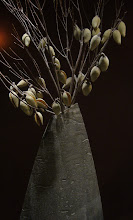 Formally known as nigella damascena, this ethereal flower surrounded by lacy foliage is a favorite in the garden. We love it for garden-style arrangements and wedding bouquets. Used with bolder elements -- and without its feathery foliage -- the innocent-looking bloom reveals a weirder side. Originally from the Mediterranean area, this is another plant of many names: love-in-a-puzzle, lady-in-a-bower, wild fennel and, intriguingly, devil-in-a-bush are just a few. Perhaps that's why The Language of Flowers, a facsimile of a handwritten book from the Victorian era, gives its meaning as "perplexity."
Formally known as nigella damascena, this ethereal flower surrounded by lacy foliage is a favorite in the garden. We love it for garden-style arrangements and wedding bouquets. Used with bolder elements -- and without its feathery foliage -- the innocent-looking bloom reveals a weirder side. Originally from the Mediterranean area, this is another plant of many names: love-in-a-puzzle, lady-in-a-bower, wild fennel and, intriguingly, devil-in-a-bush are just a few. Perhaps that's why The Language of Flowers, a facsimile of a handwritten book from the Victorian era, gives its meaning as "perplexity."
Monday, July 28, 2008
The Flowers of Summer: Love-in-a-Mist
 Formally known as nigella damascena, this ethereal flower surrounded by lacy foliage is a favorite in the garden. We love it for garden-style arrangements and wedding bouquets. Used with bolder elements -- and without its feathery foliage -- the innocent-looking bloom reveals a weirder side. Originally from the Mediterranean area, this is another plant of many names: love-in-a-puzzle, lady-in-a-bower, wild fennel and, intriguingly, devil-in-a-bush are just a few. Perhaps that's why The Language of Flowers, a facsimile of a handwritten book from the Victorian era, gives its meaning as "perplexity."
Formally known as nigella damascena, this ethereal flower surrounded by lacy foliage is a favorite in the garden. We love it for garden-style arrangements and wedding bouquets. Used with bolder elements -- and without its feathery foliage -- the innocent-looking bloom reveals a weirder side. Originally from the Mediterranean area, this is another plant of many names: love-in-a-puzzle, lady-in-a-bower, wild fennel and, intriguingly, devil-in-a-bush are just a few. Perhaps that's why The Language of Flowers, a facsimile of a handwritten book from the Victorian era, gives its meaning as "perplexity."
Labels:
love-in-a-mist,
nigella damascena
Monday, July 21, 2008
Beautiful Flower, Not So Beautiful Name
Friday, July 11, 2008
The Plant of Many Names
 Cuban oregano. Spanish thyme. Mexican mint. Indian borage. Oregano brujo. Broadleaf thyme. Tropical oregano. Of the multitude of common names used for Plectranthus amboinicus, perhaps "three-in-one spice" is the most appropriate since oregano, thyme and mint pop up most frequently in its many monikers. It's definitely not a true oregano, a European native; the Amboinicus in its name points to an island in the Pacific. Whatever you call this plant, its fleshy leaves and fragrant aroma make it a delightful addition to the garden. A tender perennial in our area, it's a popular seasoning in the Caribbean and other parts of the world.
Cuban oregano. Spanish thyme. Mexican mint. Indian borage. Oregano brujo. Broadleaf thyme. Tropical oregano. Of the multitude of common names used for Plectranthus amboinicus, perhaps "three-in-one spice" is the most appropriate since oregano, thyme and mint pop up most frequently in its many monikers. It's definitely not a true oregano, a European native; the Amboinicus in its name points to an island in the Pacific. Whatever you call this plant, its fleshy leaves and fragrant aroma make it a delightful addition to the garden. A tender perennial in our area, it's a popular seasoning in the Caribbean and other parts of the world.
Friday, July 4, 2008
Thank you, Mr. Jefferson
 Besides the debt all Americans owe to Thomas Jefferson for crafting the Declaration of Independence, gardeners, plant and flower lovers owe him a particular debt. An ardent gardener, plant collector and record keeper, he fostered our fledgling country's interest in everything that grows, from the specimens collected by the Lewis and Clark expedition to the importation of specimen plants from abroad. Celebrate this Independence Day holiday with a look at what Jefferson nurtured in his own gardens. You might discover that some of your favorites were also his. The photo above, courtesy of the Monticello website, shows the flower garden originally tended by Jefferson's daughters and granddaughters.
Besides the debt all Americans owe to Thomas Jefferson for crafting the Declaration of Independence, gardeners, plant and flower lovers owe him a particular debt. An ardent gardener, plant collector and record keeper, he fostered our fledgling country's interest in everything that grows, from the specimens collected by the Lewis and Clark expedition to the importation of specimen plants from abroad. Celebrate this Independence Day holiday with a look at what Jefferson nurtured in his own gardens. You might discover that some of your favorites were also his. The photo above, courtesy of the Monticello website, shows the flower garden originally tended by Jefferson's daughters and granddaughters.
Subscribe to:
Posts (Atom)

